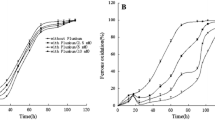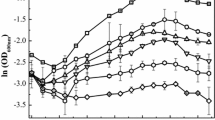Abstract
Two strains of sulfate-reducing bacteria of the genus Desulfovibrio (A2 and TomC) isolated from metal mining waste were able to grow on agar Postgate C nutrient medium under microaerobic conditions. Since their growth in liquid nutrient medium was just slightly affected by 1% O2 (initial concentration in the gas phase) and 0.05–0.1 mM H2O2, these strains were relatively oxygen-tolerant. Only the presence of oxidants in high concentrations (5–10% О2 or 0.3–1.0 mM H2O2) resulted in practically complete inhibition of their growth. Strain A2 was more resistant to oxidative stresses than strain TomC. Activities of the key enzymes of antioxidant defense—superoxide dismutase (SOD), catalase, and peroxidase—were revealed in the cell-free extracts of strain A2 grown under strict anaerobic conditions. While strain TomC was found to possess no peroxidase activity, its catalase activity was much higher than that of strain A2 (36 and 2 U/mg protein, respectively). SOD activity of both strains was almost the same (5 U/mg protein). Sublethal H2O2 doses (concentration of 0.05–0.15 mM and exposure for 45–240 min) resulted in a drastic increase of catalase activity, especially in strain A2. Sublethal О2 doses (1–2% in the gas phase) had no significant effect on activities of the antioxidant enzymes of both strains. The cytochrome composition determined from the absolute absorption spectra of the whole cells of strains TomC and A2 revealed the presence of the c heme (438 and 831 pmol/mg protein) and the d heme (336 and 303 pmol/mg protein, respectively). The presence of the d heme indicated the presence of the bd heme–heme quinol oxidase, which together with the c heme may provide for the functioning of the electron transport segment of the antioxidant defensive system, which is responsible for aerotolerance of sulfate-reducing bacteria.
Similar content being viewed by others

References
Baumgarten, A., Redenius, I., Kranczoch, J., and Cypionka H., Periplasmic oxygen reduction by Desulfovibrio species, Arch. Microbiol., 2001, vol. 176, pp. 306–309.
Belevich, I., Borisov, V.B., Zhang, J., Yang, K., Konstantinov, A.A., Gennis, R.B., and Verkhovsky, M.I., Timeresolved electrometric and optical studies on cytochrome bd suggest a mechanism of electron-proton coupling in the diheme active site, Proc. Natl. Acad. Sci. U. S. A., 2005, vol. 102, pp. 3657–3662.
Berry E.A., Trumpower B.L. Simultaneous determination of hemes a, b, and c from pyridine hemochrome spectra, Anal. Biochem. 1987, vol. 161, pp. 1–15.
Brioukhanov, A.L., Durand, M.-C., Dolla, A., and Aubert, C., Response of Desulfovibrio vulgaris Hildenborough to hydrogen peroxide: enzymatic and transcriptional analyses, FEMS Microbiol. Lett., 2010, vol. 310, pp. 175–181.
Brioukhanov, A., Pieulle, L., and Dolla, A., Antioxidative defense systems of anaerobic sulfate-reducing microorganisms, in Current Research, Technology and Education Topics in Applied Microbiology and Microbial Biotecnology, Mendez-Vilas, A., Ed, Badajoz: Formatex Research Center, 2010, vol. 1, pp. 148–159.
Bryukhanov, A.L., Netrusov, A.I., Shestakov, A.I., and Kotova, I.B., Metody issledovaniya anaerobnykh mikroorganizmov (Methods for Investigation of Anaerobic Microorganisms), Moscow: Nauch. Bibl. MGU, 2015.
Coulter, E.D. and Kurtz, D.M., A role for rubredoxin in oxidative stress protection in Desulfovibrio vulgaris: catalytic electron transfer to rubrerythrin and two-iron superoxide reductase, Arch. Biochem. Biophys., 2001, vol. 394, pp. 76–86.
Cypionka, H., Oxygen respiration by Desulfovibrio species, Annu. Rev. Microbiol., 2000, vol. 54, pp. 827–848.
Cypionka, H., Widdel, F., and Pfenning, N., Survival of sulfate-reducing bacteria after oxygen stress, and growth in sulfate-free oxygen sulfide gradients, FEMS Microbiol. Ecol., 1985, vol. 31, pp. 39–45.
Dannenberg, S., Kroder, M., Dilling, W., and Cypionka, H., Oxidation of H2,organic compounds and inorganic sulfur compounds coupled to reduction of O2 or nitrate by sulfate-reducing bacteria, Arch. Microbiol., 1992, vol. 158, pp. 93–99.
Davydova, M.N. and Sabirova, R.Z., Anti-oxidant defence of the cell Desulfovibrio desulfuricans B-1388, Anaerobe, 2003, vol. 9, pp. 39–41.
Dolla, A., Fournier, M., and Dermoun, Z., Oxygen defense in sulfate-reducing bacteria, J. Biotechnol., 2006, vol. 126, pp. 87–100.
Dos Santos, W.G., Pacheco, I., Liu, M.-Y., Teixeira, M., Xavier, A.V, and LeGall, J., Purification and characterization of an iron superoxide dismutase and a catalase from the sulfate-reducing bacterium Desulfovibrio gigas, J. Bacteriol., 2000, vol. 182, pp. 796–804.
Fareleira, P., Santos, B.S., Antonio, C, Moradas-Ferreira, P., LeGall, J., Xavier, A.V., and Santos, H., Response of a strict anaerobe to oxygen: survival strategies in Desulfovibrio gigas, Microbiology (UK), 2003, vol. 149, pp. 1513–1522.
Fournier, M., Aubert, C., Dermoun, Z., Durand, M.-C., Moinier, D., and Dolla, A., Response of the anaerobe Desulfovibrio vulgaris Hildenborough to oxidative conditions: proteome and transcript analysis, Biochimie, 2006, vol. 88, pp. 85–94.
Fournier, M., Zhang, Y., Wildschut, J.D., Dolla, A., Voordouw, J.K., Schriemer, D.C., and Voordouw, G., Function of oxygen resistance proteins in the anaerobic, sulfatereducing bacterium Desulfovibrio vulgaris Hildenborough, J. Bacteriol., 2003, vol. 185, pp. 71–79.
Frazao, C., Silva, G., Gomes, C.M., Matias, P., Coelho, R., Sieker, L., Macedo, S., Liu, M.Y., Oliveira, S., Teixeira, M., Xavier, A.V., Rodrigues-Pousada, C., Carrondo, M.A., and Le Gall, J., Structure of dioxygen reduction enzyme from Desulfovibrio gigas, Nat. Struct. Biol., 2000, vol. 7, pp. 1041–1045.
Gallati, H., Horseradish peroxidase: a study of the kinetics and the determination of optimal reaction conditions, using hydrogen peroxide and 2,2'-azinobis 3-ethylbenzthiazoline-6-sulfonic acid (ABTS) as substrates, J. Clin. Chem. Clin. Biochem., 1979, vol. 17, pp. 1–7.
Imlay, J.A., How oxygen damages microbes: oxygen tolerance and obligate anaerobiosis, Adv. Microb. Physiol., 2002, vol. 46, pp. 111–153.
Jenney, F.E., Verhagen, M.F., Cui, X., and Adams, M.W., Anaerobic microbes: oxygen detoxification without superoxide dismutase, Science, 1999, vol. 286, no. 5438, pp. 306–309.
Johnson, M.S., Zhulin, I.B., Gapuzan, M.E., and Taylor, B.L., Oxygen-dependent growth of the obligate anaerobe Desulfovibrio vulgaris Hildenborough, J. Bacteriol., 1997, vol. 179, pp. 5598–5601.
Karnachuk, O.V., Mardanov, A.V., Avakyan, M.R., Kadnikov, V.V., Vlasova, M., Beletsky, A.V., Gerasimchuk, A.L., and Ravin, N.V., Draft genome sequence of the first acid-tolerant sulfate-reducing deltaproteobacterium Desulfovibrio sp. TomC having potential for minewater treatment, FEMS Microbiol Lett., 2015, vol. 362, no. 4. doi 10.1093/femsle/fnv007
Karnachuk, O.V., Sasaki, K., Gerasimchuk, A.L., Sukhanova, O., Ivasenko, D.A., Kaksonen, A.H., Puhakka, J.A., and Tuovinen, O.H., Precipitation of Cu-sulfides by copper-tolerant Desulfovibrio isolates, Geomicrobiol. J., 2008, vol. 25, pp. 219–227.
Krekeler, D., Teske, A., and Cypionka, H., Strategies of sulfate-reducing bacteria to escape oxygen stress in a cyanobacterial mat, FEMS Microbiol. Ecol., 1998, vol. 25, pp. 89–96.
Lamrabet, O., Pieulle, L., Aubert, C., Mouhamar, F., Stocker, P., Dolla, A., and Brasseur, G., Oxygen reduction in the strict anaerobe Desulfovibrio vulgaris Hildenborough: characterization of two membrane-bound oxygen reductases, Microbiology (UK), 2011, vol. 157, pp. 2720–2732.
Lemos, R.S., Gomes, C.M., Santana, M., LeGall, J., Xavier, A.V., and Teixeira, M., The ‘strict’ anaerobe Desulfovibrio gigas contains a membrane-bound oxygen-reducing respiratory chain, FEBS Lett., 2001, vol. 496, pp. 40–43.
Lumppio, H.L., Shenvi, N.V., Summers, A.O., Voordouw, G., and Kurtz, D.M., Rubrerythrin and rubredoxin oxidoreductase in Desulfovibrio vulgaris: a novel oxidative stress protection system, J. Bacteriol., 2001, vol. 183, pp. 101–108.
Machado, P., Felix, R., Rodrigues, R., Oliveira, S., and Rodrigues-Pousada, C., Characterization and expression analysis of the cytochrome bd oxidase operon from Desulfovibrio gigas, Curr. Microbiol., 2006, vol. 52, pp. 274–281.
Manchini, S., Abicht, H.K., Karnachuk, O.V., and Solioz M., Genome sequence of Desulfovibrio sp. A2 a highly copper resistant,sulfate-reducing bacterium isolated from effluents of a zinc smelter at the Urals, J. Bacteriol., 2011, vol. 193, pp. 6793–6794.
McCord, J.M. and Fridovich, I., The utility of superoxide dismutase in studying free radical reactions. I. Radicals generated by the interaction of sulfite, dimethyl sulfoxide, and oxygen, J. Biol. Chem., 1969, vol. 244, pp. 6056–6063.
Mukhopadhyay, A., Redding, A.M., Joachimiak, M.P., Arkin, A.P., Borglin, S.E., Dehal, P.S., Chakraborty, R., Geller, J.T., Hazen, T.C., He, Q., Joyner, D.C., Martin, V.J.J., Wall, J.D., Yang, Z.K., Zhou, J., and Keasling, J.D., Cell-wide responses to low-oxygen exposure in Desulfovibrio vulgaris Hildenborough, J. Bacteriol., 2007, vol. 189, pp. 5996–6010.
Nelson, D.P. and Kiesow, L.A., Enthalpy of decomposition of hydrogen peroxide by catalase at 25 degrees C (with molar extinction coefficients of H2O2 solutions in the UV), Anal. Biochem., 1972, vol. 49, pp. 474–478.
Pereira, P.M., He, Q., Xavier, A.V., Zhou, J., Pereira, I.A.C., and Louro, R.O., Transcriptional response of Desulfovibrio vulgaris Hildenborough to oxidative stress mimicking environmental conditions, Arch. Microbiol., 2008, vol. 189, pp. 451–461.
Pierik, A.J., Wolbert, R.B.G., Portier, G.L., Verhagen, M.F.J.M., and Hagen, W.R., Nigerythrin and rubrerythrin from Desulfovibrio vulgaris each contain two mononuclear iron centers and two dinuclear iron clusters, Eur. J. Biochem., 1993, vol. 212, pp. 237–245.
Sigalevich, P., Meshorer, E., Helman, Y., and Cohen, Y., Transition from anaerobic to aerobic growth conditions for the sulfate-reducing bacterium Desulfovibrio oxyclinae results in flocculation, Appl. Environ. Microbiol., 2000, vol. 66, pp. 5005–5012.
Silva, G., LeGall, J., Xavier, A.V., Teixeira, M., and Rodrigues-Pousada, C., Molecular characterization of Desulfovibrio gigas neelaredoxin, a protein involved in oxygen detoxification in anaerobes, J. Bacteriol., 2001, vol. 183, pp. 4413–4420.
Wildschut, J.D., Lang, R.M., Voordouw, J.K., and Voordouw, G., Rubredoxin:oxygen oxidoreductase enhances survival of Desulfovibrio vulgaris Hildenborough under microaerophilic conditions, J. Bacteriol., 2006, vol. 188, pp. 6253–6260.
Author information
Authors and Affiliations
Corresponding author
Additional information
Original Russian Text © A.L. Bryukhanov, V.A. Korneeva, T.Yu. Dinarieva, O.V. Karnachuk, A.I. Netrusov, N.V. Pimenov, 2016, published in Mikrobiologiya, 2016, Vol. 85, No. 6, pp. 625–634.
Rights and permissions
About this article
Cite this article
Bryukhanov, A.L., Korneeva, V.A., Dinarieva, T.Y. et al. Components of antioxidant systems in the cells of aerotolerant sulfate-reducing bacteria of the genus Desulfovibrio (strains A2 and TomC) isolated from metal mining waste. Microbiology 85, 649–657 (2016). https://doi.org/10.1134/S0026261716060047
Received:
Published:
Issue Date:
DOI: https://doi.org/10.1134/S0026261716060047



